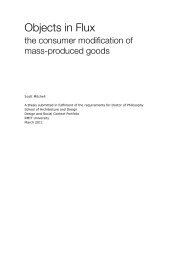Making Memory Space: Recollection and Reconciliation in Post ...
Making Memory Space: Recollection and Reconciliation in Post ...
Making Memory Space: Recollection and Reconciliation in Post ...
Create successful ePaper yourself
Turn your PDF publications into a flip-book with our unique Google optimized e-Paper software.
the complexity of attempt<strong>in</strong>g to re-characterise the <strong>in</strong>nate mean<strong>in</strong>g of monuments, <strong>and</strong> the difficulty of<br />
accommodat<strong>in</strong>g a diverse audience is born out through discussion of the Voortrekker Monument,<br />
which st<strong>and</strong>s as sem<strong>in</strong>al object of Afrikaner nationalism <strong>and</strong> entitlement.<br />
The Voortrekker Monument<br />
Figure 2 - Stoicism <strong>in</strong> the monument. One of four corner<br />
sculptures depict<strong>in</strong>g the ‘Great leaders of the trek’: Piet Retief,<br />
Andreas Pretorius, Hendrik Potgieter <strong>and</strong> an unknown leader<br />
represent<strong>in</strong>g all the others<br />
The Voortrekker Monument is the product of the<br />
desire of the Afrikaner population to construct a<br />
physical manifestation of their entitlement to the<br />
l<strong>and</strong> of South Africa, <strong>in</strong>tended as verification of<br />
their supremacy both as a race <strong>and</strong> a spiritual<br />
people aligned with God. 109 This impulse, the<br />
desire to ‘generate political legitimisation through<br />
the symbolic possession of urban spaces’, has<br />
been consistent <strong>in</strong> the Western world from<br />
antiquity onwards. 110 Accord<strong>in</strong>g to Sigfreid<br />
Giedion, such constructs display an ‘eternal need<br />
of people to create symbols for their activities <strong>and</strong><br />
for their fate or dest<strong>in</strong>y, for their religious beliefs<br />
<strong>and</strong> for their social convictions.’ 111 The<br />
Voortrekker Monument conforms to just such as assertion. Great care was taken with its design,<br />
placement <strong>and</strong> execution to ensure that it assumed its <strong>in</strong>tended significance. Each aspect of the<br />
memorial, its site, structure, materiality <strong>and</strong> form, was <strong>in</strong>fused with a deliberate significance to highlight<br />
Afrikaner ascendancy over Southern Africa (Figure. 2).<br />
Monumental Narratives<br />
The Voortrekker Monument was built <strong>in</strong> the late 1930s <strong>and</strong> foreshadows a style popular among other<br />
build<strong>in</strong>gs constructed dur<strong>in</strong>g the Apartheid era. 112 The Monument was constructed to commemorate<br />
the Great Trek: a historical event whereby Afrikaner pioneers left the Cape of Good Hope to establish<br />
a new settlement <strong>in</strong> the area of the former Transvaal (now Gauteng). The Trek was <strong>in</strong>tended as an act<br />
of resistance aga<strong>in</strong>st British Colonialism, <strong>and</strong> as a result, the monument is considered anti-British as<br />
well as anti-African. 113 Attempts to refashion the memorial’s mean<strong>in</strong>g are made doubly complex by its<br />
relationship to the colonis<strong>in</strong>g forces of the British whilst represent<strong>in</strong>g the colonis<strong>in</strong>g force of the<br />
109<br />
Annie E. Coombes, Op cit, p.28.<br />
110<br />
Peter Carrier, Holocaust Monuments <strong>and</strong> National <strong>Memory</strong> Cultures <strong>in</strong> France <strong>and</strong> Germany s<strong>in</strong>ce 1989 (New York <strong>and</strong><br />
Oxford: Berghahn Books, 2005), p.17.<br />
111<br />
Sigfried Giedion, ‘The Need for a New Monumentality’, <strong>in</strong> Architecture <strong>and</strong> You <strong>and</strong> Me, (Cambridge <strong>and</strong> Massachusetts:<br />
Harvard University Press, 1958), p.28.<br />
112<br />
Roger Fisher, ‘The native heart: The architecture of the University of Pretoria campus’, <strong>in</strong> Hilton Jud<strong>in</strong> <strong>and</strong> Ivan Vladislavic,<br />
Blank________ Architecture, Apartheid <strong>and</strong> After (Rotterdam: NAi Publishers, 1998), p.226.<br />
113<br />
Sampie Terreblanche, A History of Inequality <strong>in</strong> South Africa 1652-2002 (Pietermaritzburg: University of Natal Press, 2002),<br />
p.219.<br />
38
















